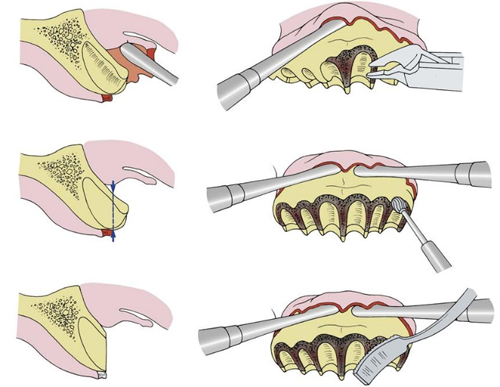Alveoloplasty is a common surgical procedure that involves reshaping and re-contouring the jawbone ridges. Alveoloplasty is also known as alveoplasty. It can be performed right after a tooth extraction, or as an individual procedure. After a tooth is extracted there are areas of the bone that are sharp and uneven. Those edges and irregularities can cause a lot of problems in the future when the patient needs dentures. That is why alveoloplasty is performed and the best option if possible is to be done right after the extraction.
Reasons:
The main reason why a patient would need an alveoplasty is the extraction of a tooth or teeth. The second one is a natural or traumatic loss of teeth. Every single tooth is placed in an alveolar socket lined with bone. Once the tooth is lost, the edges of the socket can have very sharp edges. These edges usually are a problem in terms of irritation. Once the patient gets a restoration such as a crown, denture, bridge, the gum at that location will get irritated by the bone, and the patient might experience pain and discomfort. The main goal is to achieve a jawbone that is susceptible to further treatment. There is a number of complications that can happen including a problem with retention of the dentures, pain, wounds, discomfort, problems with stability and more. So in other words, the alveoloplasty can be associated with two different reasons:
Associated with tooth extraction:
This type can be performed right after the extraction or after a certain period. It is mostly up to the dentist and the individual case of the patient. If the dentist notices that the contours of the bone after the extraction are raw, and they might cause problems later, he will perform an alveoloplasty. If some problems appear after the wound has healed, then the dentist has to do a second surgical procedure and perform an alveoloplasty after a certain period after the extraction. Multiple tooth extractions are also an indication for this surgical procedure. Since this leaves a lot of raw edges, the chances are that the dentist will have to intervene right after the extraction to avoid the second surgery. That makes things easier both for the dentist and the patient.
Other factors:
These include factors such as natural bone reshaping or the wear of dentures for a longer time. No one can predict exactly how a restoration will interact with the surrounding tissues. Very often, due to age, the bone can resorb unevenly and leave some raw or irregular parts. Once the patient starts feeling difficulties, that might mean they need an alveoloplasty.
Procedure:
The procedure is fairly simple. If done right after an extraction, the dentist simply rounds up the uneven parts and leaves a smooth bone, that also speeds up the process of healing. It helps the further wear of fixed and mobile appliances. If done in a certain period after the extraction, the dentist has to do a cut or open a gum flap to get access to the bone. Then with the help of special instruments, they smoothen the surface. This usually requires stitches, but the recovery period is fast and easy.





